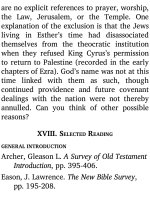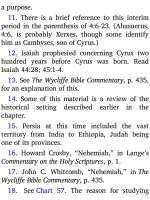Jensens survey of the old testament adam 143
Bạn đang xem bản rút gọn của tài liệu. Xem và tải ngay bản đầy đủ của tài liệu tại đây (117.79 KB, 4 trang )
Providence pervades the narrative.24 It is
the same One who preserved the nation of
Israel in the oppressions of Pharaoh, and
through such devastating judgments as
those of the wilderness journeys, the
Assyrian and Babylonian invasions, the
destruction of Jerusalem in A.D. 70, and
Hitler’s mass slaughters.
XIII. SURVEY OF ESTHER
1. Follow the usual procedures of survey
study. After you have scanned the book,
read the entire story more slowly. Because
of its intriguing plot, the book holds one’s
attention throughout.
2. Four people are the main characters of
the narrative: King Ahasuerus, Esther,
Mordecai, and Haman. Observe the part
played by each, as you read the story.
3. Where is the turning point of the Jews’
situation?
4. Try making an outline of the book. In
your own words, state the book’s theme.
5. Study survey Chart 64. Compare its
outlines with your own observations.
6. Observe the elevation of a Jewess,
Esther, in chapter 2, and the exaltation of a
Jew, Mordecai, in chapter 10.
7. What were the occasions for the feasts
of the book? Note the comparison made of
the feasts of chapters 1 and 9.
XIV. PROMINENT SUBJECTS OF ESTHER
A. THE JEWS ARE THREATENED
A key word of the book is “Jew.” The
singular form appears eight times; the plural
form, forty-three times. The term Jew is
derived from the word Judah. Since most of
the returning exiles were of the tribe of
Judah, the title Jew was applied to them,
and extended in later years to all Hebrew
people.
The fate of the Jews throughout centuries
of unbelief has been one endless tragedy.
Wars, famines, broken homes, political
upheaval, plagues, and premature death
were some of the judgments of the years of
judges and kings. Then came the
deprivations of the Assyrian and Babylonian
captivities; coldness of heart in the four
hundred years before Christ; and a
worldwide dispersion to the present day for
the rejection of the Messiah. The slaughter
of millions of Jews by the Hitler regime
reveals how much hatred the human race is
capable of heaping upon à people.
The story of Esther concerns deliverance
for the Jews during exile years. The book
does not intend to extol the Jew, but to
show that the fate of the nation—good or
bad—is in the hands of a sovereign God.
There have been tragic pogroms in the
history of Israel, but there have also been
miraculous deliverances, and the book of
Esther records one such deliverance.
As of chapter 3, the extermination of all
Jews in Xerxes’ empire merely awaited the
arrival of the day of slaughter, eleven
months later, on the thirteenth of Adar
(3:13). That date had been determined by
lot (“Pur,” see 3:7). The decree was
distributed in letter form by couriers
throughout the empire, ordering the
authorities “to destroy, to kill, and to
annihilate all the Jews, both young and old,
women and children, in one day” (3:13).
What made the king sign such a decree?
(3:2).
(4:1—10:3)
From time to time God has raised up
B. THE JEWS ARE SPARED









